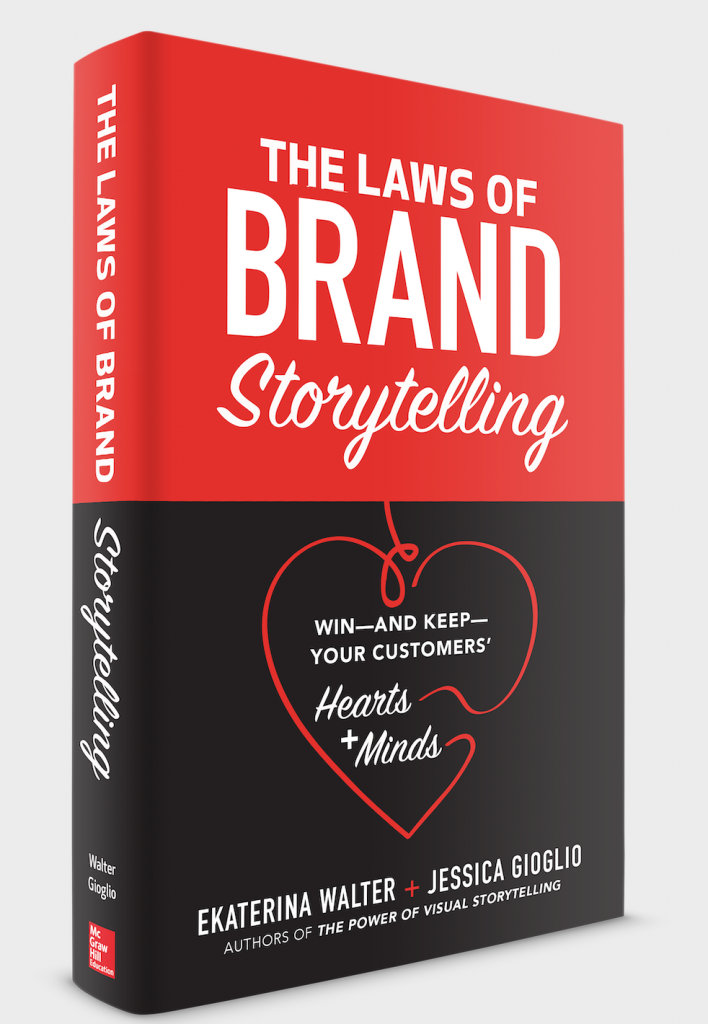Guest Post by Ekaterina Walter and Jessica Gioglio
In the era of the connected digital consumer, brand storytelling needs to undergo a radical shift. For many companies, brand storytelling has become a buzzword, a way to support marketing campaigns or polished commercials. So much so, that we’ve lost our focus on the heart and soul of brand storytelling.
It’s time we took the BS out of brand storytelling and focus on what truly matters: building the meaningful and relevant connections with our customers.
In our new book,The Laws of Brand Storytelling, we talk about the impact storytelling-done-right has on your business and provide a roadmap which you can use to plug in your own brand storytelling strategy and approach to achieve that impact.
In this post, however, let’s address the top brand storytelling misconceptions that are holding most companies back from achieving that impact:
Misconception #1: “Brand storytelling is only a marketing function”
Look closely at the top brand storytellers and you will see that a culture of storytelling extends far beyond the marketing department. The top brand storytellers empower employees and departments across the organization to craft a cohesive story that’s visible at every single touchpoint of the customer experience journey. From company values, to the culture inside your company, product packaging, customer care, and more, everything you do – and how you do it – becomes a story, it becomes your brand. Although we as marketers often pull off incredible feats solo, if we truly want to reach new levels of success and shape remarkable customer experiences, it’s time to acknowledge that we cannot and should not go at it alone. The more we can shift our companies to view brand storytelling as a thread that runs across the organization and connects us to our employees, customers, suppliers, partners and more, the more impactful our stories will be.
A great example of this comes from Microsoft. Microsoft has 4,000 employees worldwidethat are empowered to be brand storytellers. Miri Rodriguez, Storyteller at Microsoft, emphasizes the importance a 360-degree look across the businesswhen telling great brand stories, “Brands should be telling stories from different aspects of the business: sales, marketing, operations, customer service as each has an exclusive positioning in the brand narrative touching every aspect of the customer experience. The ultimate brand story will weave a tapestry of anecdotes and allegories into the ultimate goal and purpose of the brand.”
Microsoft’s point of view is that storytelling is not marketing content, but a business strategy that can drive cultural transformation and build valuable relationships with their customers. To bring this to life, Microsoft focuses on telling the stories of its customers, who they call, “Real People of Action.” Compared to traditional customer case studies, Microsoft tells the customer journey story, including the ups, downs, lessons learned, key supporters and achievements. By shining a spotlight on customers in an authentic way, Microsoft has been incredibly successful in their brand storytelling efforts.
Misconception #2: “Our story is boring and not worth telling.”
We often hear from companies that, “Our product or company is boring. No story will make it attractive.“ Listen, for every boring product there is a community that uses it and appreciates it. On the company front, if your company is so boring, how did it attract you and your fellow employees to work there? Surely there must be something exciting and noteworthy about the work culture, products, company values or other perks that attracted you and your colleagues to the business.
If Charmin can make toilet paper interesting through storytelling, you can do it with your company. Just look at Maersk, the Danish transport and logistics conglomerate. Their Instagram page boasts over 100,000 followers and it’s a page dedicated to posting pictures and videos of the shipping vessels and shipping containers. Shipping containers! On its social media channels, Maersk tells the story of what it’s like to carry millions of tons of cargo every single day through stunning visuals and accompanying captions. From traveling the Panama Canal, installing the world’s first system to clean pieces of plastic from the Pacific, or celebrating Pride with its employees, Maersk shines a spotlight on its work, but also its values. As a result of their storytelling efforts, they’ve grown and cultivated a highly engaged community. And not only on Instagram. They have millions of fans on their Facebook page, several very active LinkedIn groups that debate industry trends, and a number of other social media channels to connect with their niche audiences on.
The next time you’re tempted to brush off brand storytelling because of a “boring” product or industry, remember, remarkable is in the eye of the beholder. If you have a strong sense of who you are, what you stand for, the culture you want to nurture and the customer experience you want to deliver, great stories will not be far behind.
Misconception #3: “Our brand is the hero of our story”
Carly Simon said it best, “You’re so vain, you probably think this song is about you.” Well, this song (and story) is not about you. Too often, companies default to the messages and stories they want to tell versus what’s truly interesting and relevant to their customers. The reality? Consumers want stories they can relate to. Stories that move them, spark emotions like laughter, empathy, inspiration, and ultimately, leave them motivated to take action. So much so, that if companies only default to their brand as the hero of their story, they’re doing themselves a disservice and missing a major opportunity.
Instead, consider other heros to shine a spotlight on in your stories, such as:
- Customers and their families
- Employees
- Partners
- Franchisees / Licensees
- Stakeholders
- Industry peers
- Influencers
- Volunteers
- Mascots
- Causes
- Change movements
- Etc.
A related misconception is that a brand can only have one hero to its story. For example, Borrow My Doggy, a startup based in the UK and Ireland, uses storytelling and a shared love for dogs to connect dog owners with trusted local people who would love to look after another person’s dog. The company’s aim is to help dog owners when they need it, give dogs more exercise and playtime and to allow people without a dog to spend quality time with one. Instead of simply trying to promote its service offerings, Borrow My Doggy uses storytelling to shine a spotlight on its dog owner and dog borrower communities. As a result, there are many heroes within its brand story. From the story of its inspiring founder, to the company’s purpose and mission, and the many powerful stories from dog owners and borrowers, there are many heroes. Each hero takes center stage at different times over the course of the brand’s life and they do so in a way that aligns back to the customer experience Borrow My Doggy provides.
Final Thoughts
In a time when brand storytelling is becoming ubiquitous, companies need to view storytelling as sacred. If you’ve ever been captivated by a story, whether it’s written or verbal, you understand that there’s a magic to storytelling when it’s done right. There’s an art and science to telling incredible stories, so let’s not settle for the average or mediocre ones – let’s prioritize the brand stories and principles that truly matter.
Storytelling isn’t about projecting your desired image of your company or products. It’s not about dropping overly branded stories into marketing campaigns or tactics to spark customer engagement. With consumers more empowered than ever before, your brand isn’t what you say it is anymore, it is what consumers say it is. Capturing customers’ hearts and minds today requires businesses to prioritize emotional connections with their customers, to be in the moment, having authentic conversations, and to share relevant, inspiring stories that move and motivate people to take action.
Are you ready to tell your brand’s story?
Ekaterina Walter and Jessica Gioglio are the co-authors of The Laws of Brand Storytelling: Win―and Keep―Your Customers’ Hearts and Minds (Nov. 2018).






Leave a Reply